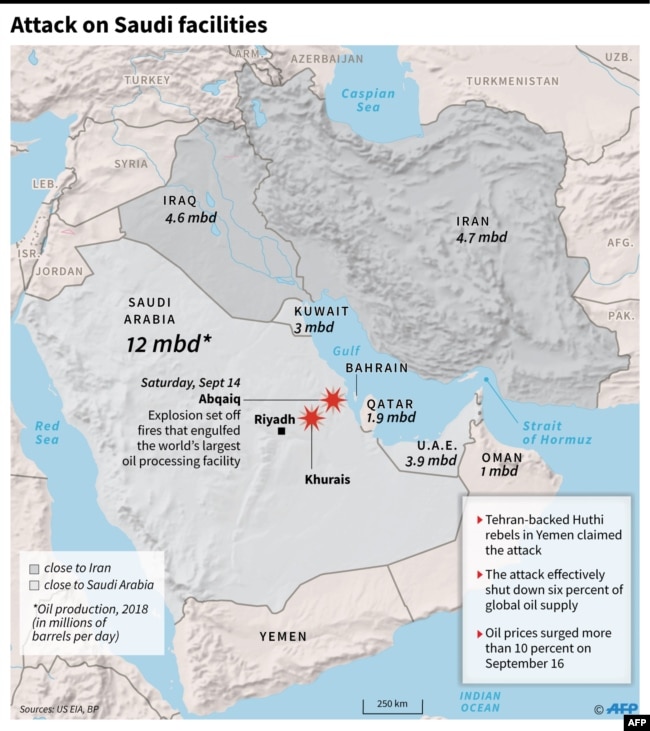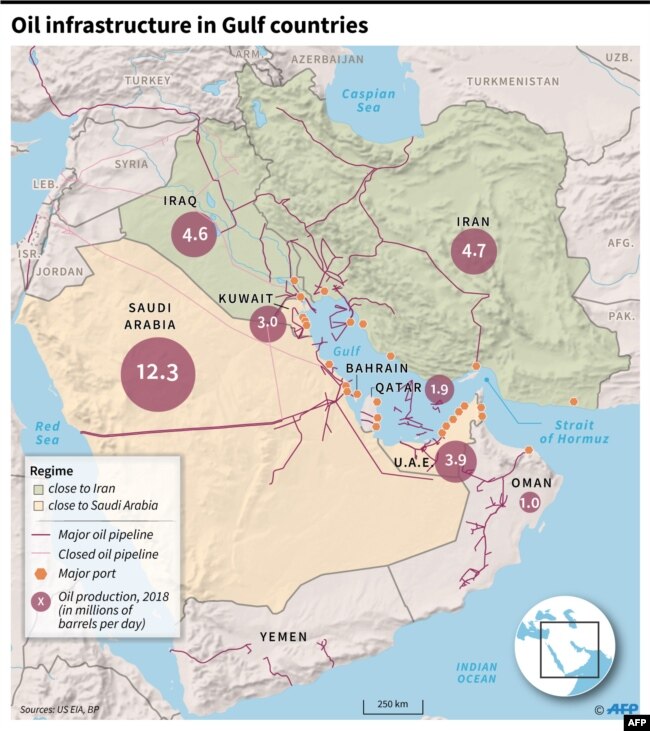Radiofarda – Two days after the devastating attacks on Saudi Arabia’s oil establishments that halved the country’s oil output, a Trump Administration official has told ABC News it was Iran that launched the attack using “a dozen cruise missiles and over 20 drones from its territory.”
ABC has characterized the accusation as an “extraordinary charge,” although other sources have also speculated about the attack having originated from somewhere in Iraq or Iran.
The network added that that “President Donald Trump warned the U.S. was “locked and loaded” to respond to the attack on Sunday, waiting for verification of who was responsible and for word from Saudi Arabia on how to proceed.”
Earlier, Secretary of State Mike Pompeo had named Iran as the responsible party for the attack on oil installations in Abqaiq and Khurais, in Eastern Saudi Arabia, one of the world’s largest oil processing facilities.

Iran’s Foreign Minister Mohammad Javad Zarif on Sunday denied Tehran’s involvement and accused Pompeo of “maximum deceit.” Pompeo on the other hand tweeted that there was no evidence to determine the attacks came from Yemen.
Houthi rebels in Yemen have assumed responsibility for the attacks, but the U.S. official who spoke to the ABC said, “The Houthis are claiming credit for something they did not do.” He said Trump was aware that “Iran is responsible.”
At this juncture if new attacks occur, or if Washington determines Iran was directly responsible for the attack, the U.S. will have little choice but to respond. Any retaliation will bring about more attacks against Saudi Arabia and more infrastructure damage. President Donald Trump tweeted a pledge of support to allies in the region on Monday, committing the U.S. to defending them. But full defense might prove to be impossible.
In a video released on YouTube, Harold Brown, the director of Transnational Threats Projects at the Center for Strategic and International Studies, presented an estimate of Iran’s capability to attack’s Saudi interests in the oil rich zone and the Saudi vulnerabilities in the area, as well as offering insight on Iran’s possible way out of the escalation and what the United States can do.
He said Iran currently has the military and cyber capability to cause “significant damage to Saudi Arabia’s critical infrastructure,” adding that “targeting Saudi Arabi’s oil infrastructure has massive global impact on everything from oil prices to everything that come out of their refineries.”
Expounding on Iran’s “overwhelming” missile capabilities against Saudi Arabia, Brown said “The challenge right now is that Saudi Arabia is so vulnerable that defensive measures, while they are important, will not ever solve the problem.”
He added: “What the U.S. and its partners need to do is to deter Iranian action by making it very clear if Iran were to target Saudi’s critical infrastructure, they would be on the receiving end of very tough response.” He also highlighted that the United States needs to make it clear for Iran what is its exit ramp for getting out of this crisis and what Iran needs to do in order to de-escalate the tension.
If the U.S. ignores the attack, Iran will prove it has military dominance in the region and If it responds militarily it can risk more destruction. The attack on September 14 proved that Iran has the capability to do serious damage throughout the region./**/ /**/ /**/ SEE ALSO:Trump Says US ‘Locked And Loaded’ But Waiting ‘Verification’ After Saudi Attack
In the meantime, while speculations still continue on where the attacks were launched from, the impact on Saudi Arabia’s oil production facility has been affecting the markets with a spike in energy prices.
Reuters has called the attack “the worst disruption to world supplies on record,” adding that “Benchmark Brent crude gained nearly 20% in the first moments of trading Monday before settling down to over 8% higher as trading continued. A barrel of Brent traded up $5.33 to $65.55. That spike represented the biggest percentage value jump in Brent crude since the lead up to the 1991 Gulf War that saw a U.S.-led coalition expel Iraqi dictator Saddam Hussein’s forces from Kuwait.”
The developments over the weekend, raised the level of tensions in the Persian Gulf region to its highest peak in recent months. The new level of escalation on Sunday, as the ABC put it “heightened fears of a conflict between Iran and its proxies against the Saudis and the U.S.”

 Shabtabnews In this dark night, I have lost my way – Arise from a corner, oh you the star of guidance.
Shabtabnews In this dark night, I have lost my way – Arise from a corner, oh you the star of guidance.


